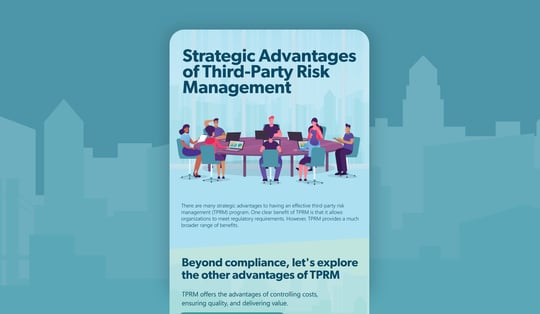Venminder’s Thought Leadership interview series features in-depth conversations with third-party risk management industry experts sharing their insights, experiences and thoughts on current topics. Recently, I sat down with Michael Kossman, Chief Operations and Compliance Officer for leading private wealth management firm, Aspiriant. With over 30 years of business experience, Michael brings a broad range of expertise to the table, including operations, finance, human resources, technology, taxation, regulatory environments and strategic planning. It was no surprise that Michael had quite a bit of useful insight to share.
Third-Party Risk Management Complexity and Challenges
Our conversation began as I asked Michael about his background with third-party risk management (TPRM). Michael had recognized third-party risk becoming more prevalent over the last decade but had little direct involvement with TPRM until he was in the Chief Operating and Compliance Officer role. As the executive who was accountable for his firm’s compliance with the Securities and Exchange Commission’s (SEC) data privacy rule, Michael jumped headlong into developing an appropriate TPRM program. Soon after, Aspiriant launched mutual funds and added FINRA regulations and the California Consumer Privacy Act (CCPA) to the growing list of compliance requirements.
Even with his extensive business expertise, the complexity of third-party risk management initially took Michael by surprise. “It’s not just about data; it is about how data is governed and managed as well as the policies and procedures of the third parties,” Michael remarked.
According to Michael, his firm faced some challenges when implementing a TPRM program, some of which are typical for all organizations and some that are unique to asset management firms:
- Third-party participation and response: Obtaining responses from third-party vendors was often a time-consuming process requiring substantial human intervention.
- Need for different methods: A one-size-fits-all approach wasn’t practical to manage the risk of all the firm’s vendors. Processes were then customized in proportion to the scope and scale of the risks presented.
- Client expectations: Unlike a traditional banking relationship, wealth management advisors are expected to access all the client’s information. Like most wealth management firms, Aspiriant doesn’t store this client information directly, but is instead housed across multiple third parties.
- User access: Junior ranking employees are often the most privileged users. They’re the individuals scanning confidential documents and placing them in client folders. This type of access demands additional levels of information security control and requires background checks on all employees. The firm is dependent on a third-party provider to conduct those checks, further emphasizing the need for solid third-party risk management.
- Fourth parties: Many organizations that work with the firm outsource their servers to fourth parties, so it’s critical to understand who has access to their client’s data and how it’s protected while at rest and in transit.
- Regulatory compliance: Asset management firms are regulated by the SEC and FINRA, which have different regulatory concerns than those of the financial services regulators.
- Physical security: While not unique to the asset management industry, it’s also worth noting the importance of physical or hard data security when protecting client information, especially related to fourth parties. Michael shared the example of an office building landlord who hires a cleaning company, which now becomes an organization’s fourth party. This fourth party has full access to your physical space and can easily view sensitive or customer data if left out on an employee’s desk.
Strategies for Accountability in Third-Party Risk Management
We also discussed one of the most frequent concerns of third-party risk practitioners, which is the reluctance of first-line business owners to perform TPRM functions. Michael agreed that TPRM is an important business practice but is often overlooked unless something goes wrong.
To emphasize the importance of TPRM and ensure both internal and external accountability, he recommends the following methods:
- Share personal experiences: People can relate to actual incidents that have occurred, so personal stories are helpful to understand risk better. Michael states, “Get people to relate to it personally and involve them in both the process and the correction of problems when they occur.”
- Use internal oversight: As Michael pointed out, “A TPRM program won’t govern itself.” There must be an individual who has the internal role of holding people accountable and ensuring that the various activities are accomplished.
- Highlight the rewards and consequences: Using a “carrot and stick” approach can incentivize desired actions and get others to understand the downside consequences. For example, an organization might say that a vendor won’t get paid unless they have properly gone through the third-party risk process.
Best Practices for Board and Senior Leadership Engagement and Involvement
Many organizations have felt that TPRM doesn’t get enough attention from the board and senior leadership. As a C-level executive, Michael offered these best practices to ensure that the tone and culture come from the top:
- Point to compliance: There’s much value in reminding the board and senior management that TPRM is regulatory compliance. Looking back at previous exams will reveal past expectations and how the organization responded.
- Consistent reporting: It’s very common for TPRM to get all the attention when something goes wrong, but the focus shifts elsewhere over time. Sustaining engagement from the board can be achieved by consistently reporting to the executive committee.
My conversation with Michael generated great dialogue and some very helpful insights and suggestions. We hope that you find it useful when considering your approach to third-party risk management. To hear more from Michael’s interview, listen here.











